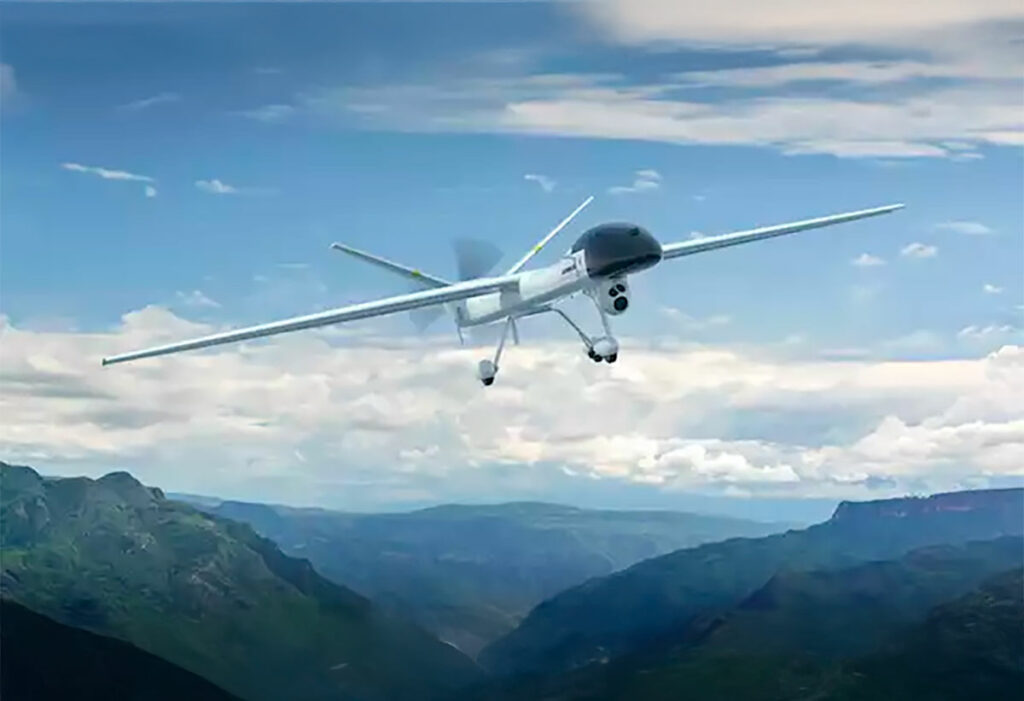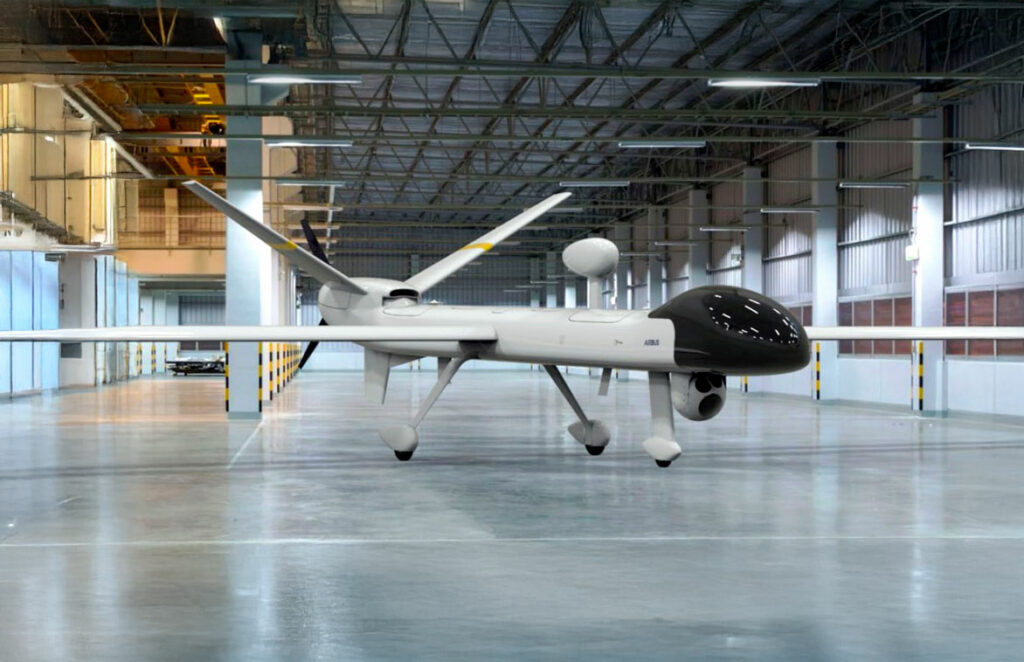The Airbus SIRTAP is a high-performance tactical unmanned aircraft system designed for advanced ISR missions, featuring over 20 hours endurance and a 150 kg payload capacity.
The Airbus SIRTAP is a tactical unmanned aircraft system (TUAS) developed to meet the advanced intelligence, surveillance, and reconnaissance (ISR) needs of modern military forces. With a maximum takeoff weight of 750 kilograms (1,653 pounds) and a payload capacity exceeding 150 kilograms (330 pounds), it supports dual payload configurations, such as an electro-optical/infrared (EO/IR) turret and a multi-mission radar. The SIRTAP offers an endurance of over 20 hours and operates at altitudes up to 21,000 feet (6,400 meters). Designed for all-weather operations, it features systems enabling functionality in temperatures ranging from -40°C to +50°C. The aircraft is optimized for rapid deployment, with a modular design allowing disassembly for transport in platforms like the C295 tactical transport aircraft. Its versatility extends to various mission profiles, including armed ISR, maritime surveillance, electronic warfare, and border security.
History of the Development of the Airbus SIRTAP
In the early 2020s, the increasing complexity of global security challenges underscored the need for advanced ISR capabilities within military operations. Traditional manned reconnaissance platforms presented limitations in endurance, risk exposure, and operational flexibility. Recognizing these constraints, defense agencies sought unmanned solutions that could offer prolonged operational periods, reduced risk to personnel, and adaptability across various mission profiles.
Airbus, leveraging its extensive experience in aerospace innovation, initiated the development of a high-performance tactical unmanned aircraft system to address these emerging requirements. The project, initially named Atlante II, was conceived to provide a TUAS that could seamlessly integrate into existing military frameworks while delivering enhanced ISR capabilities. The objective was to create a system capable of operating in the most demanding environments, offering both endurance and versatility.
The development program gained significant momentum when Airbus secured a contract with the Spanish Ministry of Defence in November 2023. This agreement encompassed the development and acquisition of the SIRTAP system, marking a pivotal step in the project’s advancement. The contract specified the delivery of nine systems, each comprising three unmanned aerial vehicles (UAVs) and a ground control station, along with two simulators for comprehensive training purposes.
The SIRTAP is designed to enhance the tactical capabilities of both the Spanish Army and the Air and Space Force. Its development focuses on providing advanced ISR capabilities, enabling forces to conduct surveillance and reconnaissance missions under the most demanding conditions, both day and night, over land and sea. The system is engineered to operate in extreme climates, capable of withstanding temperatures ranging from -40°C to +50°C, ensuring functionality across diverse operational theaters.
A notable design consideration was the system’s deployability. The SIRTAP features a modular design that allows for rapid disassembly, facilitating transport in tactical transport aircraft such as the C295. This capability ensures that the system can be quickly deployed to various operational areas, enhancing its strategic value.
The development timeline was structured to achieve critical milestones efficiently. The Critical Design Review (CDR) was successfully completed in June 2024, affirming the system’s design maturity and readiness for subsequent phases. Following the CDR, Airbus initiated the final assembly of the first prototypes at its facility in Getafe, Madrid. The inaugural prototype is scheduled for completion in the spring of 2025, with ground testing to commence shortly thereafter. The first flight is anticipated before the end of 2025, marking a significant milestone in the program’s progression.
The SIRTAP’s development reflects a collaborative effort between Airbus and various industry partners. For instance, Sener Group was contracted to design and develop the Line-of-Sight (LOS) data link systems, ensuring robust and secure communications between the UAV and ground control stations. Additionally, Volz Servos, a German actuator specialist, was selected to supply actuators for the air conditioning system, contributing to the aircraft’s ability to operate in extreme temperatures. These partnerships underscore the integrative approach adopted in the SIRTAP’s development, combining expertise from multiple domains to achieve a sophisticated and reliable system.
The SIRTAP is poised to become Spain’s first fully domestically developed military aviation system in the Class II/III category. This achievement signifies a substantial advancement in Spain’s aerospace capabilities, highlighting the nation’s commitment to fostering indigenous technological innovation within its defense sector. The program not only aims to enhance national defense capabilities but also to stimulate growth within the domestic aerospace industry through an Industrial Participation Plan, integrating numerous Spanish companies into the development and production processes.

Design of the Airbus SIRTAP
The Airbus SIRTAP exhibits a design focused on versatility, endurance, and operational efficiency. Its airframe measures 7.3 meters (23.9 feet) in length, with a wingspan of 11.3 meters (37.1 feet) and a height of nearly 2.5 meters (8.2 feet). This configuration provides a balance between aerodynamic performance and payload capacity.
The aircraft’s maximum takeoff weight (MTOW) is 750 kilograms (1,650 pounds), supporting a payload capacity exceeding 180 kilograms (396 pounds). This substantial payload allowance enables the integration of multiple sensor systems simultaneously, such as an electro-optical/infrared (EO/IR) turret and a multi-mission radar. This dual-payload capability enhances the SIRTAP’s effectiveness in complex ISR missions.
The SIRTAP’s propulsion system consists of a conventional engine driving a three-bladed propeller in a pusher configuration, located at the rear of the fuselage. This arrangement contributes to aerodynamic efficiency and reduces noise signature, which is advantageous for ISR operations.
The aircraft’s structural design includes a modular architecture, allowing for rapid disassembly of components such as wings and rotors. This feature facilitates transportation in standard containers and tactical transport aircraft like the C295, enabling quick deployment to various operational theaters.
The SIRTAP is engineered for all-weather operations, featuring an ice protection system and the ability to operate in temperature extremes ranging from -40°C to +50°C. This capability ensures mission readiness in diverse environmental conditions, including rain and maritime environments.
The landing gear is designed for operations on unpaved runways as short as 800 meters (2,625 feet) and includes an autotaxi capability. This enhances the aircraft’s versatility in austere environments where infrastructure may be limited.
In terms of avionics, the SIRTAP integrates advanced navigation systems developed by industry partners, ensuring precise flight control and mission execution. The aircraft is also equipped with Line-of-Sight (LoS) and Beyond-Line-of-Sight (BLoS) communication systems, including satellite communication (SATCOM), extending its operational range and providing robust data link capabilities.
The design incorporates a V-tail configuration with outward-canted tailplanes and a single ventral fin, contributing to aerodynamic stability and control. The mid-mounted wings are positioned along the fuselage to optimize aerodynamic performance and payload distribution.
Performance of the Airbus SIRTAP
The Airbus SIRTAP is engineered to deliver robust performance across various mission profiles, particularly in intelligence, surveillance, and reconnaissance (ISR) operations.
Engine and Power:
The SIRTAP is powered by a conventional internal combustion engine driving a three-bladed propeller in a pusher configuration. While specific engine power output details are not publicly disclosed, this setup is designed to provide efficient propulsion, balancing fuel consumption with the aircraft’s endurance requirements.
Speed:
The aircraft achieves a maximum true airspeed (TAS) exceeding 110 knots, equivalent to approximately 126.6 miles per hour (mph) or 203.7 kilometers per hour (km/h). This speed allows the SIRTAP to cover significant areas during missions, ensuring timely data collection and responsiveness.
Altitude:
With a service ceiling surpassing 21,000 feet (6,400 meters), the SIRTAP operates effectively above most weather systems and potential threats, providing a strategic vantage point for ISR activities.
Range and Endurance:
The SIRTAP boasts an operational range exceeding 2,000 kilometers (1,243 miles), facilitated by both Line-of-Sight (LoS) and Beyond-Line-of-Sight (BLoS) communication capabilities via satellite communication (SATCOM). Its endurance exceeds 20 hours, enabling prolonged mission durations without the need for frequent returns to base.
Comparative Analysis:
When compared to similar tactical unmanned aircraft systems, the SIRTAP demonstrates competitive performance metrics. For instance, the General Atomics MQ-1C Gray Eagle has a maximum speed of approximately 167 mph (270 km/h), a service ceiling of 29,000 feet.
When compared to similar tactical unmanned aircraft systems, the Airbus SIRTAP demonstrates competitive performance metrics. For instance, the General Atomics MQ-1C Gray Eagle has a maximum speed of approximately 192 mph (309 km/h), a service ceiling of 29,000 feet (8,839 meters), and an endurance of 25 hours. Its maximum takeoff weight is 3,600 pounds (1,633 kilograms), with a payload capacity of 800 pounds (360 kilograms).
In comparison, the SIRTAP’s maximum speed exceeds 110 knots (126.6 mph or 203.7 km/h), with a service ceiling surpassing 21,000 feet (6,400 meters), and an endurance exceeding 20 hours. Its maximum takeoff weight is 1,650 pounds (750 kilograms), supporting a payload capacity exceeding 396 pounds (180 kilograms).
While the Gray Eagle offers higher speed, altitude, and payload capacity, the SIRTAP provides a balance of performance and versatility suitable for various ISR missions. Its modular design and rapid deployability make it a valuable asset for military forces requiring adaptable and efficient unmanned systems.
Variants of the Airbus SIRTAP
As of now, there are no publicly disclosed variants of the Airbus SIRTAP. The platform is designed to be versatile and adaptable, capable of supporting various payloads and mission configurations to meet diverse operational requirements. Future developments may include specialized variants or upgrades to enhance specific capabilities, but such information is not currently available.

Military Use and Combat of the Airbus SIRTAP
The Airbus SIRTAP is primarily designed for intelligence, surveillance, and reconnaissance (ISR) missions. Its payload capacity allows for the integration of various sensor systems, including electro-optical/infrared (EO/IR) turrets and multi-mission radars, enhancing its ability to gather critical battlefield information.
While the SIRTAP is not primarily designed as an armed platform, its payload capacity and modular design could potentially allow for the integration of light munitions, depending on mission requirements and customer specifications.
As the SIRTAP is a relatively new system, there are no publicly available records of its deployment in active combat operations. The system is currently under development, with the first flight anticipated before the end of 2025. Once operational, it is expected to be utilized by the Spanish Army and the Air and Space Force for ISR missions.
The SIRTAP has not been sold to other countries as of now. However, its design and capabilities may attract interest from international customers seeking a versatile and efficient tactical unmanned aircraft system.
The Airbus SIRTAP represents a significant advancement in tactical unmanned aircraft systems, offering a balanced combination of endurance, payload capacity, and operational versatility. Its modular design facilitates rapid deployment and adaptability across various mission profiles, making it a valuable asset for modern military forces. While it may not match the higher performance metrics of some counterparts like the MQ-1C Gray Eagle, the SIRTAP’s design emphasizes efficiency, flexibility, and ease of deployment, aligning well with the evolving demands of contemporary ISR operations.
Back to the Drones, UAVs, UCAVs page